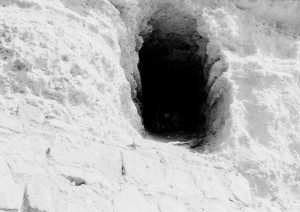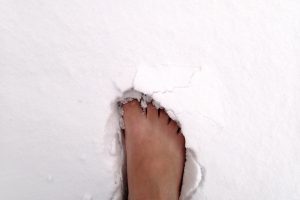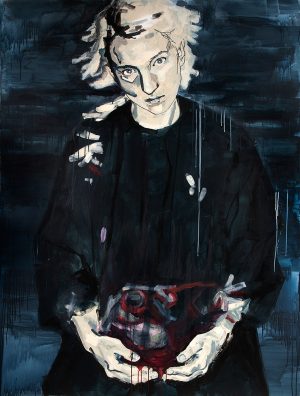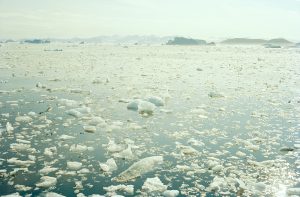“Stop all that self-pitying stuff, because it isn’t a pity for you. Enough of that post-colonial piece of shit.” These lines, the second of which is written in English in the original, are from HOMO sapienne (2014), Niviaq Korneliussen’s (b. 1990) debut novel. The young man speaking is not only angry with the person he is telling off – he is angry with himself and his entire life. He is ashamed of his nationality, because everyone knows that ‘Greenlander’ is synonomous with social problems, low self-esteem, and a lack of qualifications and expertise – all offset by solemn talk of Greenlandic national sentiment and ancestral pride. His anger is therefore directed at the nation itself: “Our ancient land, go to the mountain and never come back. Stop being so fucking pompous, and take your crappy children with you.” Written on June 21st, Greenland’s national day. Signed: “Greenlander by force” (in English). Nunarput utoqqarsuanngoravit – Our ancient land – is the first line of the national anthem. The rest is the young man’s rewrite – which he both means and does not mean. Asking the nation to go to the mountain is an extremely forceful statement to make in Greenland. Quoted out of its context, the poem caused great offence – as intended by the author: speaking loudly in order to make her voice heard.
While during the 1970s and 1980s anger was directed at the Danes, and while the subsequent generation berated their parents for letting it all slide into partying and drinking, there has now come a time for the settling of scores, both personal and generational. This is also the case for Korneliussen’s young male character, whose anger is primarily due to his attempts to explain away a crucial element of his identity: he is gay. The five young people in the novel all transgress Greenlandic social conventions because they are either homosexual or transgender. As the narrative unfolds, they reach an understanding of their true gender identities and decide to live this reality. From the starting point of experimental gender identities, the novel thus demonstrates new identity positions beyond that of being a Greenlander – indicating a completely new approach to the literary work. HOMO sapienne does not merely break with all conventions concerning suitable topics of Greenlandic literature – above all, it breaks with the norms of how to write about it in the form of literature.

Given that Greenlandic literature has been closely linked with the national project, with pastors and school teachers often addressing young people, Greenlandic prose has had a somewhat didactic disposition with rather rigid stereotypes, including gender roles. This has led young people to seek out other media – music, television, film, and the internet – where they are more at liberty to experiment without the pressure to adhere to the normative view of language associated with written literature. While some Greenlandic authors write in Danish, Greenlandic literature is associated with the Greenlandic language, one of the strongest markers of Greenlandic identity. As bearer of the nation-building project, Greenlandic literature commands an aura of the sublime as a specific site for the preservation of linguistic ‘correctness’, maintaining a ‘pure and unadulterated’ Greenlandic free from the influence of Danish and English. Interest in written literature is apparently on the increase, not least due to young people applying the rules of the internet to literature. Everyday language, code switch, and text messages are thus mainstays of the plot in HOMO sapienne.
The novel’s reception has been overwhelming. While many have found it provocative, a majority consider the novel a new beginning for Greenlandic literature – which is appropriate, given that the book came out during the centenary of the first publication of a Greenlandic novel.
Contesting Language
Greenlandic, Kalaallisut, has been the sole official language since the Greenland Home Rule Act of June 2009. However, not all Greenlanders speak Greenlandic. Danish has been the language of administration and the idiom of power since the colonisation in 1721, and while Greenlandic has been prioritised since 1979, a high level of expertise in Danish – and English – is still necessary in order to pursue further education. Multilingualism was previously regarded with suspicion and, particularly in the case of mixed marriages, the fear of children becoming confused by having access to two languages and cultures often led parents to prioritise the Danish language.

Today, everyone wants their children to be bi- or multilingual but in practice this is not always so easy, particularly in Nuuk with its high proportion of Danish-speakers. On the other hand, the inability to speak/read Greenlandic makes it difficult to keep up with current events in the local community. The population is thus divided into various groups and only the bilinguals are able to keep apace with all aspects of society.
A number of female writers and artists have contributed to the public debate about language. Julie Edel Hardenberg (b. 1971), for example, is one of Greenland’s most prominent visual artists whose work juxtaposes images and words. One of her most controversial works, Ikioqatigiilluta – Jeg er grønlandsktalende (2010; I am Greenlandic-speaking) is based on an experiment: for six months, the artist had tasked herself with speaking exclusively in Greenlandic in Greenland regardless of whether or not the people she spoke to understood Greenlandic – including her friends, family, and husband. Although the artist stresses that all she did was create a situation for Danish-speakers similar to the everyday experiences of Greenlandic-speakers, reactions went from distress to outright aggression. Ikioqatigiilluta is presented as a field diary documenting, for example, everyday encounters in Nuuk where it is impossible to be served in Greenlandic: at a restaurant, travel agent, post office, and gym. Danish has become the everyday language in the capital of Greenland to the extent that even Greenlanders whose first language is Greenlandic insist on speaking Danish in public. Greenlandic-speakers are thus alienated while Danish is upheld as the demonstrable norm. Hardenberg concludes that the issue of language must be considered as part of “the tension between cultures in a post-colonial era”.
Many people were surprised by Hardenberg’s experiment, because she is known for questioning the demarcated ethnic identities that contribute to the erection of barriers between people. In Den stille mangfoldighed, Nipaatsumik assigiinngisitaarneq, The quiet diversity (2005), modern-day Greenland is depicted as a creative contact zone, comprising people from all sorts of backgrounds. Among the much-reproduced photographs is a staged picture of three children wearing Greenlandic national costumes: it is a traditional pose apart from the minor detail that the children appear to be black rather than Inuit. The title of the photograph is “Nonstereotypes”. Photo series entitled “Parents and Child” and “Siblings” demonstrate how, today, the gene pool is so compounded that one is no longer able to differentiate between Greenlanders and Europeans on the basis of physical appearance. Similarly, photographs of Greenlandic homes demonstrate how the whole world has moved in, mingling with all the objects that signify Greenlandic identity. But why make language the differential marker as is apparently the case in this language experiment? The requirement to ‘speak your own language in your own country’ would seem to support the idea of a nation with a single, privileged language spoken by the people who naturally ‘belong’ to the area in question and who are connected to that land through history and culture. In keeping with the hybridity Hardenberg insists on vis-à-vis the cultural elements, it would make far more sense to award Danish the status of being ‘native’ to Greenland rather than maintaining its status as a foreign language, not least since it has become the de facto first language for so many of Greenland’s inhabitants – including those who consider themselves Greenlanders.
Hardenberg’s language project illustrates how Greenland is in the kind of “postmonolingual condition” which literary scholar Yasemin Yildiz describes as constitutive of the present.
The notion of ‘one country, one language’ is an ill fit with the complexity of the present. It is nonetheless, the dominant paradigm which continues to delimit the boundaries of what is perceived as normal. Yildiz uses the prefix ‘post’ in the way it is used in the term, postcolonialism: while colonialism has come to an end the mindset is still there, albeit under deconstruction. One may choose to consider Hardenberg’s project as a preservation of the monolingual paradigm – but one may also take the opposite view: as a struggle to preserve Greenland as a multilingual society. The project’s Greenlandic title, Ikioqatigiilluta, means “let us help each other”. This project came about during a time where, at long last, it was finally been possible to openly discuss the difficulties experienced by Danish-speakers when trying to learn Greenlandic: the lack of opportunity to practice the language because conversations immediately switch to Danish, and the critique and ridicule meted out when non-native speakers commit even the slightest deviation in pronunciation and grammar. Hardenberg’s project, meanwhile, made no reference whatsoever to people having to speak Greenlandic perfectly – on the contrary, the project was an attempt to make the language accessible to speakers of all levels of competence. (Yasemin Yildiz: Beyond the Mother Tongue. The Postmonolingual Condition. Fordham University Press, 2012)
Performative Texts
Hardenberg’s experiment was the subject of much attention, not least due to the manner in which she assumed the monolingual role and its concomitant discomfort. She assumed the role of fieldworking ethnographer while at the same time undertaking a six-month performance as a performance artist. Performance has a strong position in contemporary Greenlandic art, not least thanks to performance artist, poet, and painter, Jessie Kleemann (b. 1959). For many years, her one-woman performances employing a number of techniques learnt during her time with the Tuukkaq Theatre in North Jutland, Denmark, have been a central aspect of her work. Kleemann has developed her own unique language which draws on Greenlandic tradition and inspiration from feminist performance artists such as Carolee Schneemann (b. 1939), Marina Abramovíc (b. 1946), Yoko Ono (b. 1933), and Kirsten Justesen (b. 1946). She outlines a scene, a conflict with simple props – a kamik boot on one foot, a high-heeled boot on the other, and a cardboard box on the floor. The artist’s body – which usually ends up entirely undressed – is central to the performance. The effect is extremely powerful and intimidating because the artist never fails to reverse the roles of performer and audience: the audience is left feeling observed rather than observing. Each performance is usually underpinned by a suite of poems in which the artist uses words as the medium to express the very subjects which are also performed through her body. Kleemann calls these poems “performative texts”, and she has recently started exhibiting and including them in new video works produced by herself or as collaborative efforts with other artists.

In interviews, Kleemann maintains that she considers poetry and performance as one and the same category. Both are a matter of getting a handle on insistent issues from the unconscious, everything which is remembered by body and mind but repressed by the decorum of everyday consciousness. Monsters thus often emerge, e.g. the mother of the sea who, in Kleemann’s representation, is a far cry from the gentle and kindly giver of modern re-interpration but is, rather, the wild and dangerous force of nature known from the ancient tales. Another figure who has been with Kleemann right from the outset is the qivittoq, or mountain wanderer. The qivittoq is someone who, in anger and shame, leaves their community and goes to live alone in the mountains. In early societies, being a human was a matter of being part of a social community. No one could cope alone in the arctic environment. The qivittoq thus ceased to be a human being while it was in recompense able to partake of the spiritual forces present in the great wilderness. These were the same powers sought by the angakkoq, the shaman. However, since the qivittoq was possessed by anger transformed by solitude into a hatred directed at all humankind, the powers became a distructive force in this form. The qivittoq was feared, but above all one feared personally going qivittoq and the stories were told as a warning against pushing anyone out of the community. In Kleemann’s performances, the qivittoq returns and confronts people with the shame that is ultimately of their own making.
Listening to Kleemann’s poems reveals a personal story of desertion and abuse. This comes across clearly in a series of poems written 2001-03 and recited by Kleemann in Ivalo Frank’s beautiful film, Killerbird (2015). The title is taken from a passage in one of the poems: “You who are the killer bird/my uncle brought/the hate in the body”. In her performances, Kleemann explains the connection between these personal feelings of shame and the ambivalent feelings of shame and pride that are, by virtue of colonisation, glued to Greenlandic identity – cf. feminist theorist, Sara Ahmed’s description of how certain emotions adhere to particular bodies through discursive practices.

The relationship between Denmark and Greenland has been characterised by decidedly asymmetrical balances of power. The Danes were in charge of all administration, claiming responsibility for all important decisions. Above all, the Danes had the right to define what was ‘civilised’ and normal, while the Greenlanders, to some extent at least, accepted the premises upon which this judgement was based. The relationship is thus comparable to Frantz Fanon’s description of the relation between the black and white races: black people had internalised the subjectivity of the white male, thereby internalising the white gaze which objectifies the black man. Fanon analyses the resulting complex relations of desire between white men and black men and between men and women transgressing the boundaries of race. This dynamic is similarly present in Greenland where the racial aspect has certainly played a role, and where marriages between Danish men and Greenlandic women were from the very outset one of the building blocks of colonial Greenland. While the hunting culture of Greenland is held in high regard, Denmark and all things Danish constituted an aspirational ideal which Greenlanders inevitably failed to achieve. In contemporary appraisals of the colonial period, it is all too easy to focus on possible Danish culpability with regards to actions or the lack thereof. This would however simply continue the colonial discourse of Danish responsibility for the Greenlanders presumed incapability of taking care of themselves. The shame experienced by Greenlanders by being placed in the position of vicitim and object thus concerns the self in its entirety, cf. Dan Zahavi’s definition of the concept of shame. Shame concerns what you are rather than what you do and the concept thus inevitably surfaces in asymmetrical power relations such as colonialism, minority-majority, and unequal gender relationships – and, not least, when these factors converge. Shame is not directly related to personal culpability, cf. the sense of shame experienced by survivors of rape and incest. (Frantz Fanon: Black Skin, White Masks. Pluto Press, 1986 [1952]; Dan Zahavi: Self and Other. Exploring Subjectivity, Empathy, and Shame. Oxford University Press, 2014)
While it would appear easier to avoid confronting the shame and look the other way, Kleemann chooses the opposite strategy: she enters the shame, examining and challenging the shame. In one of her performances, she lacerates her pregnant belly releasing kilos of whale blubber. There is much talk about Greenland’s raw materials but whale blubber was the foundation of the old culture, constituting the nexus of commercial exchange with Europe. The ulu knife, the crescent-shaped all-purpose ’woman’s knife’, is a highly-valued contemporary symbol. Whale blubber, on the other hand, embodies notions of all things primitive, bestial, dirty, malodorous – the kind of thing that rarely provokes enthusiasm in high culture. As Kleemann says, however: “The blood, the blubber and the meat do not really need explaining. As someone of a postcolonial heritage and a woman, a Greenlandic woman, I have a great need to actually own the wild side of my history.” (Ivalo Frank: “An everyday Conversation with Jessie Kleeman”. Jessie Kleemann: Qivittoq. Hurricane Publishing, 2012)
Mixed Identities

Another artist who has insisted on facing, testing, and rephrasing history and stereotypes is Pia Arke (1958-2007). In Danish discourse, it has always been popular to speak of the shared Danish and Greenlandic history as an expression of the story about the decidedly anti-colonial Danish presence in Greenland: it was all for the good of the Greenlanders and with their acceptance. The Greenlanders have found it harder to ignore the unequal power relationship and tend to speak of connected histories. However, from the vantage point of having an East Greenlandic mother, a Danish father, and a West Greenlandic upbringing, Pia Arke insisted on a de facto shared history, albeit a history far from the non-divisive picture presented by the Danish side. Arke happily called herself a ‘mongrel’, as demonstrated by changing her surname from the paternal ‘Gant’ to ‘Arke’, a Danification of her maternal surname, ‘Arqe’, which was always pronounced incorrectly anyway. ‘I make the history of colonialism part of my history in the only way I know, namely by taking it personally,’ writes Pia Arke in Scoresbysundhistorier (2003; Stories from Scorebysund, 2010).
In order to narrate the story of her own personal background, the artist intended Scoresbysundhistorier to be a cross-genre work mixing the otherwise distinct genres of science, visual arts, and literature. Equipped with the photographs she had been able to source from archives and private albums, Arke travelled to her mother’s hometown of Ittoqqortoormiit (Scoresbysund), which had been founded in the mid-1920s in the wilderness of Northeast Greenland. Alternating with a cultural geographer who describes the connections between political power, mapping, and expansion, Arke depicts the stories and memories triggered when people see the old photographs: things they would otherwise prefer not to be confronted with. The official narrative is thus replaced by quite a different story, providing a backdrop which enables us to understand the social problems afflicting the town today.
Where Kleemann focuses on the qivittoq as a contemporary symbol of the abject, the exiled aspects of culture, Arke had an eye for the tupilak: a historical creature of misfortune which would have been carved and dispatched against one’s enemies in the hope that one’s own spiritual powers exceeded those of the opponent – otherwise the tupilak would turn against its maker. In Arke’s interpretation, the tupilak became a symbol of everything that had yet to be localised and categorised and therefore representing both a threat and a potential. In an attempt to transcend the boundaries between the scientific and the spiritual/artistic approach to exploring and defining the surrounding world, Arke named one of her exhibitions Tupilakosaurus – a testatment to her signature humour, irony, and seriousness. Tupilakosaurus was also the title of her retrospective exhibition and the vast cataloguing endeavour in book form undertaken by the curatorial collective, Kuratorisk Aktion, after Arke’s death.
Pia Arke did not speak Greenlandic. She tried to learn Greenlandic as an adult but was frustrated by the fact that the language of study – West Greenlandic – bears little resemblance to her mother’s tongue, East Greenlandic. Being simultaneously an insider and outsider in various cultures, Arke also had a particular vantage point vis-à-vis the Danes’ situation in Greenland, from her point of view there was no sense in drawing up sharp distinctions between Greenlandic and Danish representations of Greenland – in order to get the full story one had to include everything.
A number of Danish writers with some form of personal connection to Greenland have studied how not only the indigenous Greenlandic body is recorded and decoded on the basis of specific discourses and narratives irrespective of the thoughts and feelings of the person in question. Not merely single men went to Greenland. Danes also brought their children along, or they had children there who would spend some of their formative years in Greenland. While many Danes have written about Greenland only a few have been emotionally involved on a personal level.
There has apparantly been some reluctance about going public with that particular story. Lotte Inuk’s (b. 1965) novel, Sultekunstnerinde (2004; The Female Hunger Artist), broke this taboo. The book depicts Nuuk in the years just before the introduction of Home Rule, at a time when the anger against the Danes was unleashed. The hierarchy in the school playground is turned upside down placing the Danish boys at the very bottom – and it is of no use for them to sing along, like everybody else, to the tunes of the Greenlandic rock band, Sume, and feeling like part of the revolution.

Several Danish writers have since drawn on their time growing up in Greenland, including Hans Jakob Helms (b. 1949), Naja Maria Aidt (b. 1963), and Iben Mondrup (b. 1969). The latter’s novel, Godhavn (2014), depicts the story of three siblings growing up in Godhavn, a West Greenland town that no longer exists since all place names were changed to Greenlandic with the introduction of Home Rule. Godhavn is now called Qeqertarsuaq and it is the main town on the island of the same name (‘the great island’: Disko). Mondrup also focuses on the role of languages as a mutually excluding factor in Greenlandic society and, like Hardenberg and Inuk, she places the blame on the school system which separated friends into ‘Greenlandic’ and ‘Danish’ classes, thereby maintaining the colonial distinction between Greenlandic and Danish. One may, in the spirit of Pia Arke, question whether these writers, given that they are working with material that is very much part of the history of modern Greenland, should not be included in a Greenlandic canon.
The Nation and Globalisation
While the nation of Greenland is still being formed it is, nevertheless, so well-established that it is a given – and thus also a worthy subject of critique. The young man’s rant against the nation in Niviaq Korneliussen’s debut novel makes sense precisely because the nation is regarded as set in stone. The young characters in the novel take their bearings from an imagined Greenlandic community and Denmark as a place to seek refuge in exile. This community is, however, no less true when the novel’s characters communicate through a reservoir of quotes and implicit messages harvested from English-language song lyrics rather than Greenlandic literature.
From being an exclusive forum in which, with a few exceptions, Greenlandic authors wrote in Greenlandic for a Greenlandic readership, Greenlandic literature is now developing towards the “heterolingual address” of Japanese-American literary scholar, Naoki Sakai, i.e. writing from a transnational perspective and having various linguistic communities as the intended readers. Only very few writers concentrate on being published exclusively in Greenlandic. Not even a writer such as Katti Frederiksen (b. 1982) – who sees her poems as a form of linguistic activism in the struggle for Greenlandic culture – resist the translation of her texts, though she refrains from doing the actual translation herself. This is an exception to the current practice where writers are usually engaged in the translation or re-creation of their works. (Naoki Sakai: Translation and Subjectivity: On “Japan” and Cultural Nationalism. University of Minnesota Press, 1997)
The absence of a Greenlandic literary institution contributes to internationalisation. Currently, literary texts are published by two Greenlandic publishing houses but there are neither Greenlandic-language editors nor professional reviewers. In 2008, Jessie Kleemann entered a collaboration with the Danish School of Creative Writing inspired by the topical interest in postcolonial issues and a desire to turn the spotlight on Greenland (Smith et al. 2010). In Greenland, this initiative served as a reminder of the nation’s lack of a school of creative writing. In 2012, several cultural institutions joined forces with Milik Publishing and launched a short-story competition for young people, entitled Allatta! (Let’s Write!). Writers of the best manuscripts participated in an intensive writing workshop run by Kleemann and the Danish writer, Mette Moestrup, who had also been co-organiser of the Greenland project at the School of Creative Writing. The edited short stories were published in a bilingual anthology, Inuusuttut – nunatsinni nunarsuarmilu / Ung i Grønland – ung i verden (2013; Young in Greenland – Young in the World). One of the short stories was written by Niviaq Korneliussen, for whom the competition served as a stepping stone to a personal publishing contract. A Danish publishing house, which offers more literary guidance, feed-back, and support could very well be the way forward for a writer such as Korneliussen. Where, we might ask, does this leave Greenlandic-language literature? However, local and distinctive themes constitute considerable capital in a globalised world – a fact which has not escaped notice in Greenland as well as in Denmark. The transnational development thus poses major challenges but equally comprises indisputable opportunities for Greenlandic literature.
- Naja Marie Aidt: Alting blinker. Gyldendal, 2009
- Pia Arke: Scoresbysundhistorier. Fotografier, kolonisering og kortlægning. Med kartografiske afsnit af Stefan Johnsson. Borgen, 2003
- Ivalo Frank: Killerbird. A film featuring poetry reading by artist Jessie Kleemann. Dansk/grønlandsk. Subtitled in English. 15. min., 2015
- Katti Frederiksen: Uummatima kissaa. Nuuk, 2006
- Katti Frederiksen: 100 % Inuk (poems in Greenlandic and Danish translated by Nuka Møller). Iperaq.com, 2012
- Julie Edel Hardenberg: Den stille mangfoldighed / Nipaatsumik assigiinngisitaarneq / The quiet diversity. Milik Publishing, 2005
- Julie Edel Hardenberg: ”Ikioqatigiilluta – Jeg er grønlandsktalende”. Kuuk : Kalaallit Nunaanni ungataanilu eqqumiitsuliorneq. Kunst i omegnen af Grønland, Iben Mondrup et al. Hurricane, 2010
- Hans Jakob Helms: Dansen i Geneve. Fortællinger fra verden. Ries, 2004
- Hans Jakob Helms: Hvis du fløjter efter Nordlyset. Milik Publishing, 2011
- Lotte Inuk: Sultekunstnerinde. Tiderne Skifter, 2004
- Jessie Kleemann: Allassimasut aallaavigalugit isiginnaartitsinermik saqqummersitsineq aamma isiginnaartitsinerit / Tekst-based performative exhibition and live performances. Katuaq, Nuuk 5.-23. februar 2015
- Niviaq Korneliussen: Homo Sapienne. Milik Publishing, 2014
- Iben Mondrup: Store Malene. Gyldendal, 2013
- ben Mondrup: Godhavn. Gyldendal, 2014
- Amalie Smith, Rasmus Graff, Lars Skinnerbach og Mette Moestrup (red.): Grønland. Kalaallit Nunaat. Legenda 9, Forfatterskolens Skriftserie, 2010
Fiction
- Sara Ahmed: The Cultural Politics of Emotion, Edinburgh University Press Ltd., 2004
- Frantz Fanon: Black Skin, White Masks. Pluto Press, 1986 [1952]
- Ivalo Frank: “An Everyday Conversation with Jessie Kleemann”. Jessie Kleemann. Qivittoq, Iben Mondrup (red.). Hurricane Publishing, 2012
- Kuratorisk Aktion (Frederikke Hansen og Tone Olaf Nielsen) (red.): Tupilakosaurus. An Incomplete(able) Survey of Pia Arke’s Artistic Work and Research. Kuratorisk Aktion, 2012
- Karen Langgaard: ”Mellem globalisering, nation building og individets dagligdag på godt og ondt: den nyeste grønlandske litteratur i teksthistorisk lys ud fra en postkolonial vinkel”. Nordica 20, 2003
- Karen Langgård: “’Vi børn kan kun sige de ting vi vil sige til vores forældre via digte’ – om relevansen af grønlandsk litteratur i et postkolonialt Grønland”. Nordiske sprog- og litteraturdage i København. Om oversættelse og kommunikation, Vigdis Finnbogadóttir et al. (red.). Nordatlantens Brygge, 2006
- Karen Langgård og Kirsten Thisted (red.): From Oral Tradition to Rap. Literatures of the Polar North. Ilisimatusarfik/Atuagkat, 2011
- Iben Mondrup (red.): Jessie Kleemann, Qivittoq. Hurricane Publishing, 2012
- Birgit Kleist Pedersen: ”Young Greenlandic writers in the public versus the anonymous space”. Nordic Voices. Literatures From the Nordic Countries, Jenny Fossum Grønn (red.). Nordisk Ministerråd, 2005
- Birgit Kleist Pedersen: ”Greenlandic Images and the Post-colonial: Is it such a big deal after all?”. The Postcolonial North Atlantic. Iceland, Greenland and the Faroe Islands, Lill-Ann Körber og Ebbe Volquardsen (red.). Berliner Beitrage zur Skandinavistik Band 20. Nordeuropa-Institut der Humboldt-Universität, 2015
- Naoki Sakai: Translation and Subjectivity: On “Japan” and Cultural Nationalism. University of Minnesota Press, 1997
- Mette Sandbye: ”Making Pictures Talk: The Re-Opening of a ’Dead City’ through Vernacular Photography as a Catalyst for the Performance of Memories.” Re-Investing Authenticity. Tourism, Place and Emotions, Britta Timm Knudsen og Anne Marit Wach. Channel View Publications, 2010
- Moritz Schramm og Kirsten Thisted: „En grønlandsk forfatter? Charlotte Inuk og ’menneskenes Land’”. Mine drømme har en andne virkelighed. Charlotte Inuk og hendes forfatterskab, Marianne Larsen og Moritz Schramm (red.). Syddansk Universitetsforlag, 2015
- Lene Therkelsen og Katja Vahl (red.): Inuusuttut – nunatsinni nunarsuarmilu / Ung I Grønland – ung I verden. Milik Publishing, 2013
- Kirsten Thisted: ”Inuk i Cyperspace.”. Grønland. Kalaallit Nunaat. Legenda 9, Forfatterskolens Skriftserie, Amalie Smith, Rasmus Graff, Lars Skinnerbach og Mette Moestrup (red.): 2010
- Kirsten Thisted: “Nationbuilding – Nationbranding. Identitetspositioner og tilhørsforhold under det selvstyrede Grønland”. Fra vild til verdensborger. Grønlandsk identitet fra kolonitiden til nutidens globalitet, Ole Høiris og Ole Marquardt (red.). Århus Universitetsforlag, 2011
- Kirsten Thisted: “De-framing the Indigenous Body. Ethnography, Landscape and Cultural Belonging in the Art of Pia Arke”. Nordlit 29, 2012
- Kirsten Thisted: ”Mine digte er også en form for oprør! Interview med Katti Frederiksen”. Tidsskriftet Grønland 4, 2013
- Kirsten Thisted: ”Hvis du fløjter efter nordlyset – dansk grønlandslitteratur ved overgangen til selvstyret”. Millennium – nye retninger i nordisk litteratur, Mads Bunch (red.). Forlaget Spring, 2013
- Kirsten Thisted: ”Kolonialisme og forsoning. Dansk-grønlandske relationer i en selvstyretid”. Tidsskriftet Grønland 3, 2014
- Yasemin Yildiz: Beyond the Mother Tongue. The Postmonolingual Condition. Fordham University Press, 2012
- Dan Zahavi: Self and Other. Exploring Subjectivity, Empathy, and Shame. Oxford University Press, 2014

